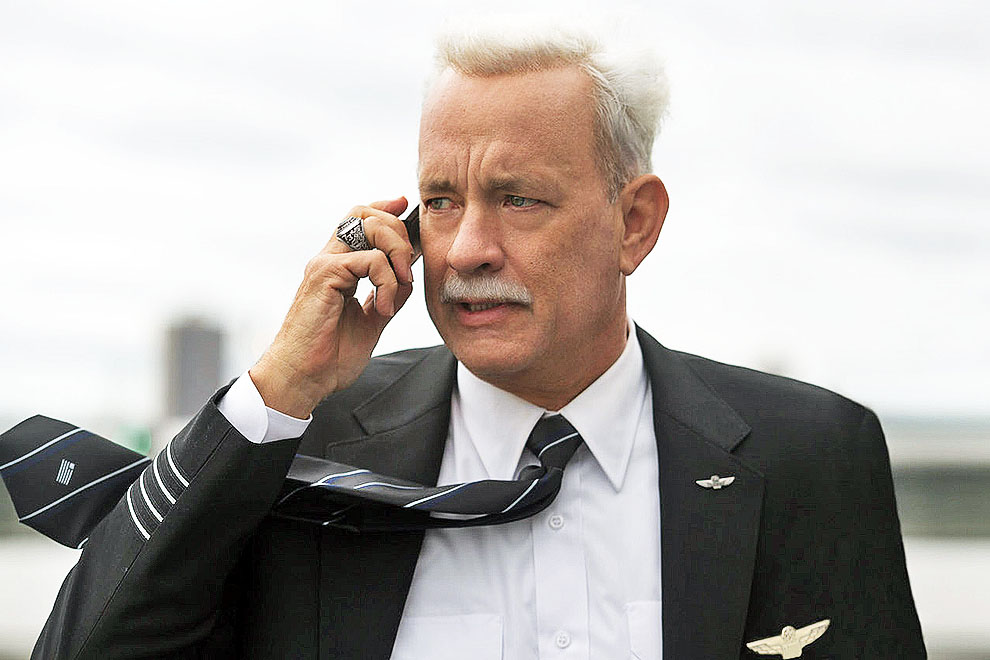Clint Eastwood’s Sully is only ninety-six minutes long, and that’s very short for a feature with a big-name lead in Tom Hanks, and a supporting cast of hundreds. It goes fast; rhythm and speed make it seem even shorter. Based on what happened to Flight 1549, New York to Charlotte, on 15 January 2009, it’s a high-end feature with a great array of special effects and two very fine central performances, Hanks’s as Captain Chesley Sullenberger – “Sully” – and Aaron Eckhart’s as his co-pilot.
In other hands, this could have been one more disaster-centred thriller with the climactic rescue at the end. Director Clint Eastwood has instead made an essay on a modest kind of heroism. We know the end at the beginning, and all the tension is built from human reaction and fast-moving technology.
As the plane takes off over New York, it is hit by a great flight of birds, disabling both engines. There isn’t time to return to La Guardia; all they can do is keep their heads down and brace for impact. Flight 1549 hits the Hudson. It will submerge; but before that occurs, all 150 passengers struggle towards the exits over the wings. In the panic, we become aware that one of them is holding a baby. Enormous airbags appear and inflate; the rescue launches converge, while Sully, knee-deep in water, checks the fast-drowning seats.
The lifeboats fill up as we watch the plane sinking. Sully is the last to leave the boat. All the passengers and crew survive.
The film’s final part, and its major tension, is concerned with Sully’s submission to interrogation by the airline’s authorities. He won’t take the credit on his own, insisting on the courage of the crew and of all concerned. But despite his insistence on the roles of co-pilot and crew, this Sully is still persistently alone, tramping through the streets, not going home to his panic-stricken wife as the news spreads round New York. In his grave persona, Hanks’s performance offers a model of the traditional kind of hero, contained and unassuming.
He confronts the airline authorities, struggling to convince them that there was no chance of turning back to La Guardia. Here, the film’s force is in the manifest gulf between the pilot and his interrogators. Although no lives were lost, the airline bureaucrats are grudging and unsympathetic, as though envying the pilot’s status as the commander, the chief agent of survival and thus the centre of a drama they can lead, but can’t own.
Most responses to Sully have endorsed the tale in its own terms, accepting its romanticism and giving in easily to the heroics; thus was a fierce struggle fought against the odds. Winning out against interrogation, Sully prevails to insist on the roles of everyone else involved in the feat of survival; but on the screen, as his own version proceeds, he’s sitting alone. Some have argued that he works as a stand-in for Eastwood himself, and that it’s all a lone-ranger kind of heroism, despite the stalwart presence of Eckhart’s Jeff Skiles. Sully himself insistently refuses the intrepid solitary role. We may end up feeling that we know too little of the people in the mass rescue – as, obediently herding out on to the wings as the plane sinks, they also refuse heroics.
Nevertheless their presences, with those of Hanks and Eckhart, make the tale in this version one that exceeds its true-story plot. It’s a piece of history drawn towards myth, and it doesn’t reduce to Eastwood’s steering role, forceful as that undoubtedly is. With some help from the audience, it can take us further than even this director meant to go. What’s really at stake in the story – one man’s applauded skill and courage, or the fates of 155? •





